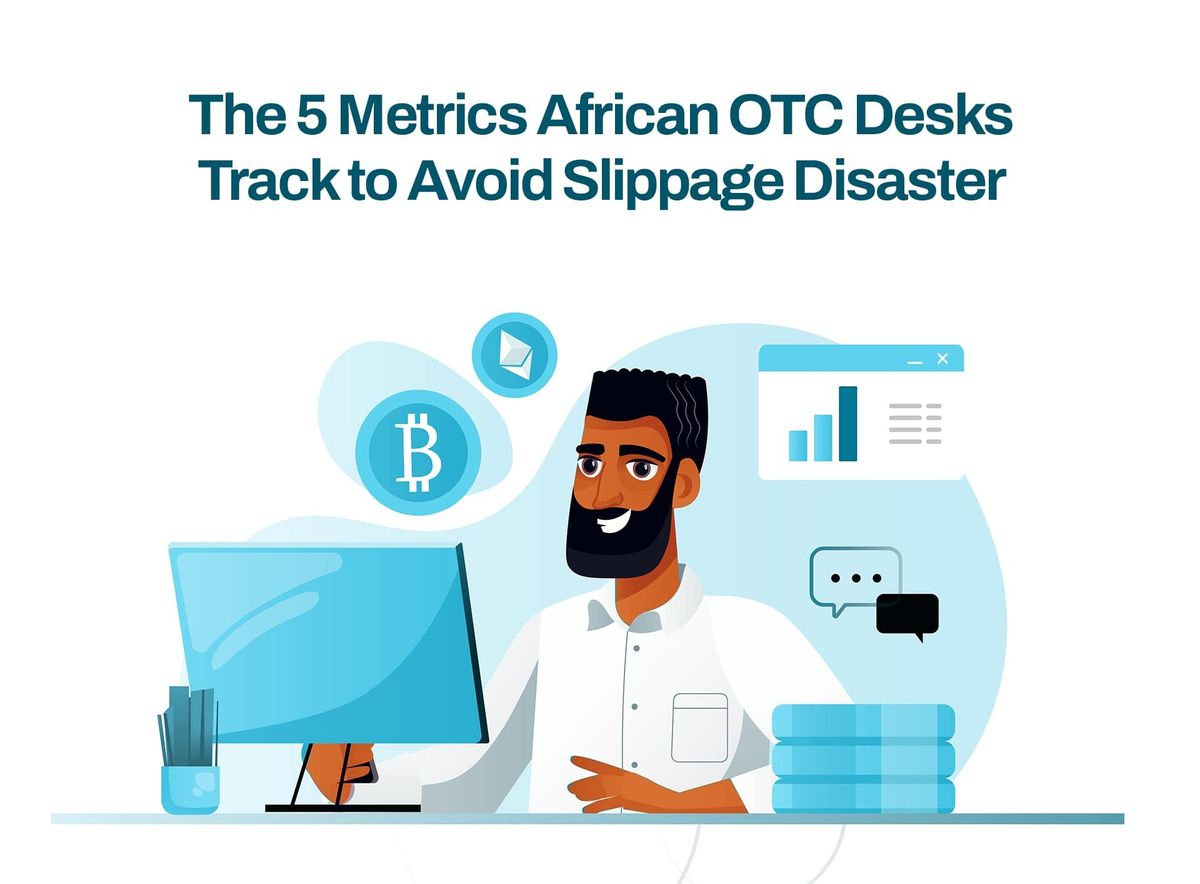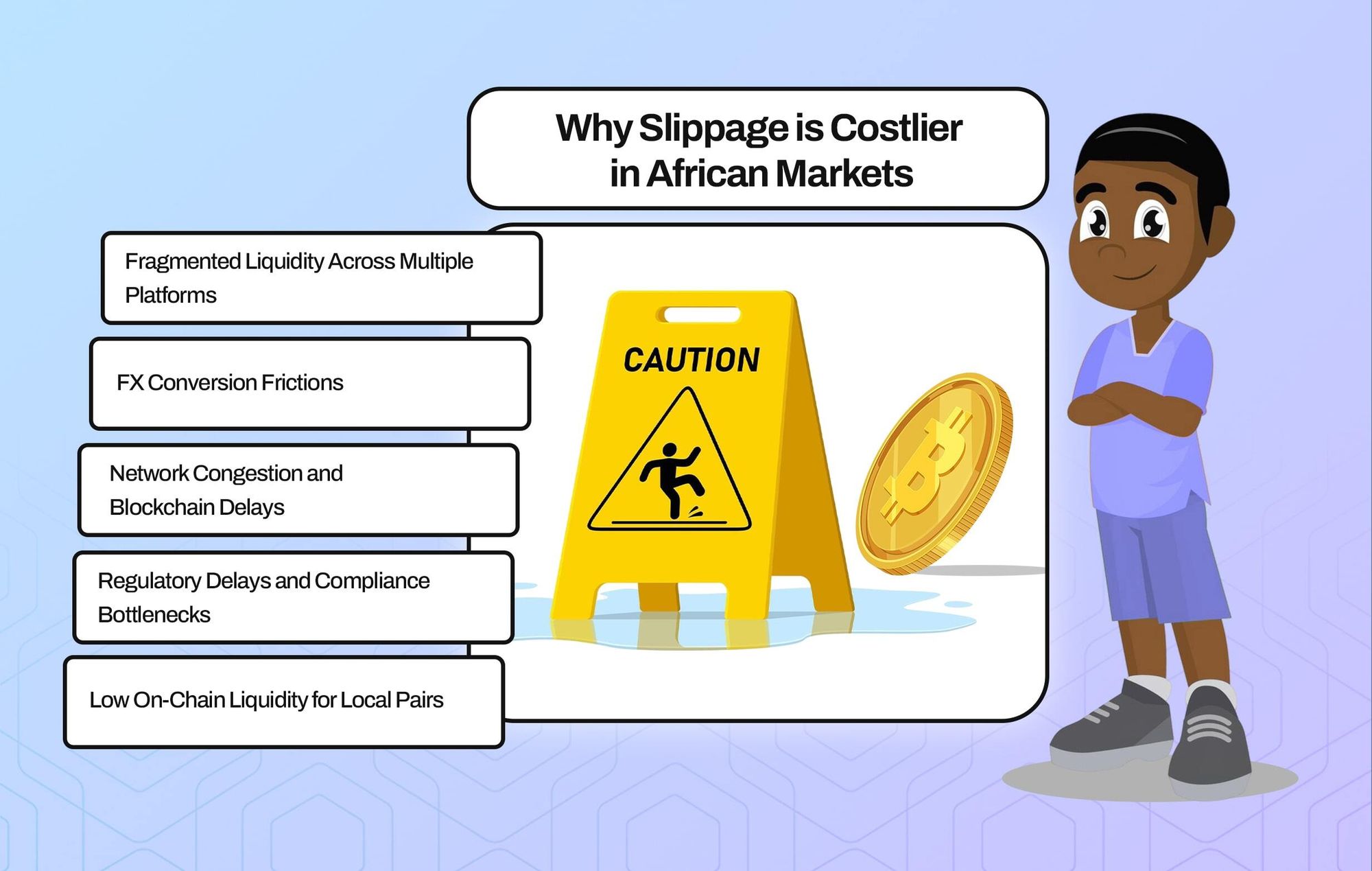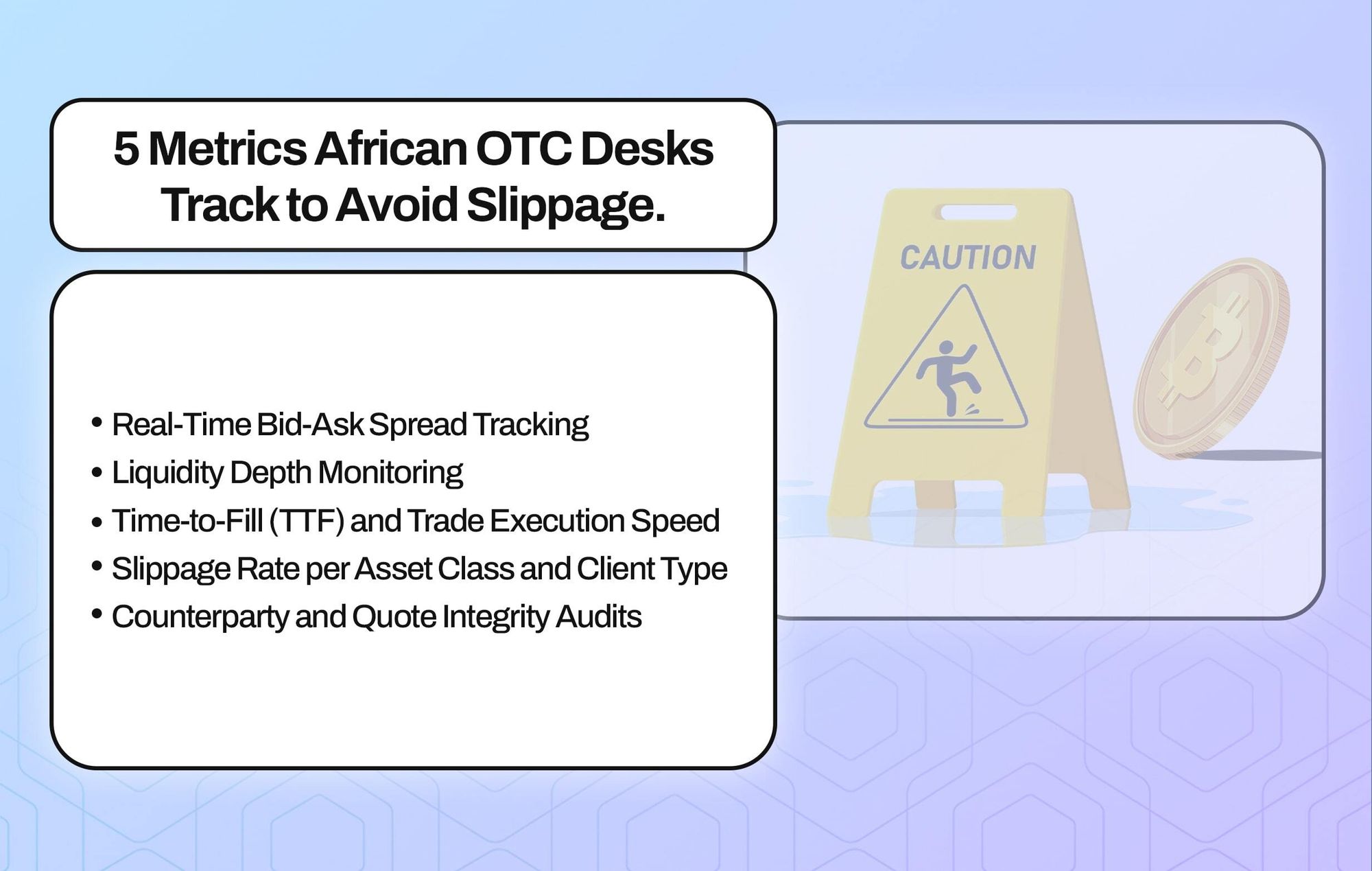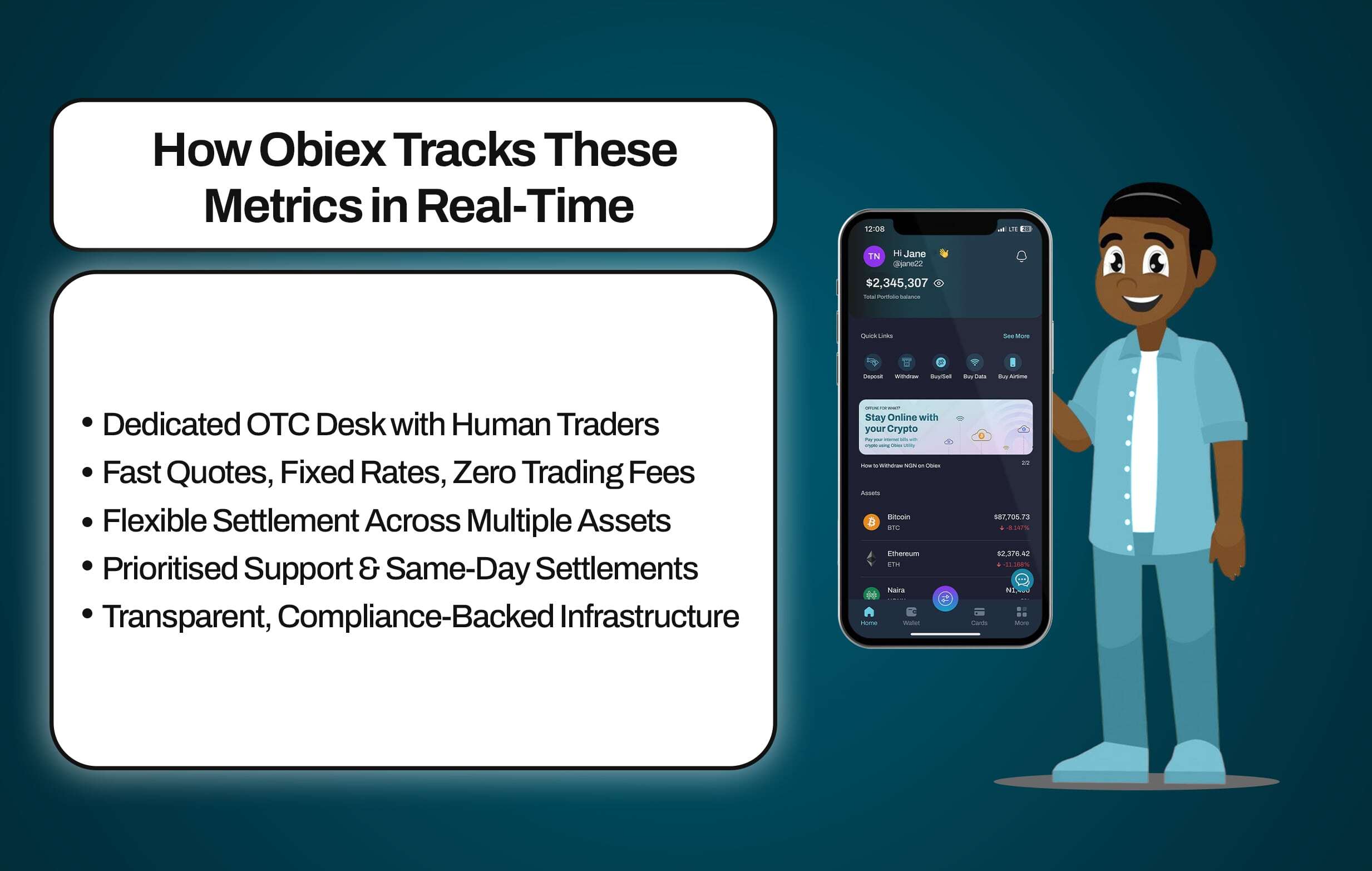The 5 Metrics African OTC Desks Track to Avoid Slippage Disaster
Learn the top 5 metrics African OTC crypto desks track to avoid slippage losses. Discover how real-time spreads, liquidity depth, and trade volume monitoring help protect profits in volatile markets.

Table of Contents
- Why Slippage is Costlier in African Markets
- 5 Metrics African OTC Desks Track to Avoid Slippage
- How Obiex Tracks These Metrics in Real-Time
- Why These Metrics Give You a Competitive Advantage
- To Recap
- FAQs
Slippage happens when the price you expect for a big OTC crypto trade changes between when you place the order and when it’s filled.
In African markets, slippage risk is even higher due to fragmented liquidity (a few big exchanges, many local OTC desks) and volatile local FX rates. For businesses trading at scale, fintechs, trading firms, treasury teams, this isn’t just a minor inconvenience. It’s a potential margin killer.
That’s why top African OTC desks, including Obiex, actively monitor five key metrics in real time. These metrics help them minimise execution risk, secure best pricing, and uphold client trust.
Let’s explore each metric in detail.
Why Slippage is Costlier in African Markets
1. Fragmented Liquidity Across Multiple Platforms:
Unlike in the U.S. or Europe where centralised exchanges have deep order books, Africa’s crypto liquidity is scattered across local exchanges, P2P networks, Telegram OTC groups, and even informal dealer networks.
That makes it harder for you to get a large trade filled at a consistent price.
Let’s say you’re trying to buy $100,000 worth of USDT. On one Nigerian exchange, you might only find $30,000 in sell orders at a good rate. The rest? You’ll have to piece it together from other sources, possibly at worse prices. That means every second spent routing the trade manually increases your exposure to price movement.
2. FX Conversion Frictions:
When you're dealing with local currencies like the Nigerian Naira (NGN), Kenyan Shilling (KES), or South African Rand (ZAR), you're also facing real-time foreign exchange (FX) volatility.
I’ve seen trades where a client wanted to convert crypto to NGN, but by the time the trade was approved internally or cleared with compliance, the exchange rate had dropped. What looked like a fair execution turned into a loss of 1–2%, just because the Naira lost ground during the delay.
Also, if you’re using banks or local payment processors to settle the fiat leg of a crypto trade, their rates and processing times can widen your slippage even more.
3. Network Congestion and Blockchain Delays:
Africa’s top-traded crypto pairs, like BTC/USDT, ETH/USDT, or USDT/NGN, often rely on blockchains like Ethereum, Tron, or BNB Chain to settle. But what happens when the network is congested?
You guessed it, confirmation delays. If you confirm a quote at 10:05 AM and your transaction doesn’t hit the blockchain until 10:15 AM due to congestion or fee prioritisation, the market could have moved against you. And in that time, the token you’re buying may have jumped by 2%, or the one you're selling may have dropped.
You end up getting less value for the same transaction size. Again, more slippage.
4. Regulatory Delays and Compliance Bottlenecks:
In some African countries, crypto transactions need to be logged, reviewed, or cleared through in-house compliance before they can settle. If you’re part of a fintech or treasury team, you already know that internal checks can take 10 to 60 minutes, especially for transactions flagged as high-risk.
While you’re waiting, the price can swing wildly, particularly during market-moving events like interest rate announcements or exchange collapses.
The more bureaucracy between quote and execution, the higher your slippage risk.
5. Low On-Chain Liquidity for Local Pairs:
If you’re trading USDT/NGN or BTC/XAF, you might be working with pairs that don’t have deep on-chain liquidity pools. Unlike global markets where assets are deeply paired on Automated Market Makers (like Uniswap or PancakeSwap), many African fiat-to-crypto pairs rely on shallow or manually sourced liquidity.
That means your trades get pushed deeper into the order book, where prices get worse and worse the more you try to fill.

5 Metrics African OTC Desks Track to Avoid Slippage
1. Real-Time Bid-Ask Spread Tracking:
What it is:
The bid-ask spread is the gap between what buyers are willing to pay (bid) and what sellers are asking (ask). The tighter the spread, the lower your risk of slippage.
If you see a BTC/USDT price of 65,000 (bid) and 65,050 (ask), the spread is $50. That’s normal. But when markets get volatile or liquidity dries up, that spread can inflate to $500 or more, especially for low-volume tokens or niche currency pairs like USDT/KES or ETH/ZAR.
Why it matters for you:
If you confirm a trade based on a narrow spread, but by the time your desk routes the order the spread has widened, you end up with a worse execution price. That’s slippage, and it costs you money on every trade.
What African OTC desks do:
Efficient desks monitor spreads in real time using tools like: Aggregated market books from global and local exchanges; Internal pricing engines that recalculate every few seconds; and Auto-alerts that trigger when spreads widen past a set threshold
This lets them either pause the quote, reroute the order, or notify you immediately before execution.
2. Liquidity Depth Monitoring:
What it is:
Liquidity depth tells you how much of an asset is actually available for purchase at different price levels, not just the top price. This matters especially when you’re executing large trades (e.g., $50,000+ per leg).
Let me give you an example. You see a quote to buy 100,000 USDT with NGN. The price looks good; ₦1,300/USDT. But that price only applies to the first ₦5 million of volume. The rest might get filled at ₦1,310, ₦1,320, or worse, depending on the actual market depth.
Why it matters for you:
If your desk only checks the surface quote (Level 1 pricing), you might get a misleading idea of how much liquidity is available. This results in partial fills or execution across multiple tiers, each one worse than the last.
What African OTC desks do:
They monitor Depth charts from multiple venues; Real-time liquidity snapshots across price levels; and Minimum quote volume thresholds for each token and currency
Some desks also split orders into smaller chunks or use algorithmic execution to minimise price impact, which helps preserve the original rate you were quoted.
3. Time-to-Fill (TTF) and Trade Execution Speed:
What it is:
Time-to-Fill (TTF) measures how long it takes from when you confirm a trade to when the order is fully executed.
A 2-second fill in a stable market may be fine. But during price swings, even a 10-second delay can make the difference between a great trade and an expensive one.
Why it matters for you:
Every second your trade stays open, you're exposed to price movement, especially in fast-moving assets like BTC, ETH, or SOL. If your desk isn’t tracking TTF closely, you could experience hidden slippage without even realising it.
What African OTC desks do:
Efficient OTC desks implement Latency monitoring systems that track every millisecond from quote to fill; Benchmarks based on asset class (e.g., <2 seconds for stablecoins, <5 seconds for altcoins); and APIs with execution timestamps, so clients like you can audit trade performance
They’ll also use smart routing algorithms that prioritise the fastest counterparties, not just the cheapest ones.
4. Slippage Rate per Asset Class and Client Type:
What it is:
This metric tracks how much slippage typically occurs for different types of assets (e.g., stablecoins vs. volatile tokens) and different types of clients (e.g., retail vs. institutional).
For example, a stablecoin trade like USDC/USDT might have an average slippage of 0.05%, while something like DOGE/NGN might average 0.9% due to low liquidity and wider spreads.
Why it matters for you:
If you’re an institutional client with regular trade volume, your OTC partner should know how your trades behave, and proactively adjust quote parameters based on your history and risk tolerance.
What African OTC desks do:
The best desks will Segment assets into slippage risk categories; Create client profiles based on trade size, frequency, and typical assets; and Set internal slippage benchmarks and thresholds per segment. That way, you get smarter quoting, better fills, and more accurate pre-trade expectations, especially when you’re trading high-risk tokens or emerging pairs.
5. Counterparty and Quote Integrity Audits:
What it is:
This is about trust. Some counterparties will show you a good price, but not actually honour it. Others may change their pricing between quote and execution, especially if the market moves sharply.
Why it matters for you:
If your quote is pulled or changed mid-trade, you’re forced to accept a worse rate, or cancel and start over, losing time and potentially money.
What African OTC desks do:
Reliable desks run regular audits to track How often quotes are honoured vs. pulled; Which counterparties adjust pricing mid-execution; and How often slippage deviates from quoted ranges
Through counterparty management, high-volume or sensitive trades only go to vetted liquidity providers with proven quote reliability and fill consistency. This protects you from last-minute quote manipulation or unfair price movement.

How Obiex Tracks These Metrics in Real-Time
1. Dedicated OTC Desk with Human Traders:
Obiex ensures you’re not stuck trading with a bot. You connect directly with actual human traders who take responsibility for each trade. That means:
- Your execution strategies can be adjusted on the fly, routing your order faster, splitting it up, or switching liquidity sources, based on the real-time metrics monitored.
- When spreads widen unexpectedly or liquidity dries up, Obiex alerts you and give you the choice to delay or tweak your trade.
This human oversight complements automated systems, keeping you ahead of volatility.
2. Fast Quotes, Fixed Rates, Zero Trading Fees:
You get live quotes within minutes, and once you lock them in, that rate is guaranteed. Here’s why it matters:
- Instantaneous price locking removes uncertainty around bid-ask spread changes.
- With zero trading fees, you see the true cost of execution, eliminating hidden costs that often masquerade as slippage.
By combining speed with transparency, you capture the rates you see on paper.
3. Flexible Settlement Across Multiple Assets:
Obiex supports settlements in NGN, USDT, BTC, SOL, and other major assets. That gives you:
- The ability to route liquidity strategically based on depth and speed.
- Alternative settlement paths if one asset or chain is congested, keeping execution smooth and cost-effective.
This flexibility means Obiex can adjust your trades dynamically to minimise slippage.
4. Prioritised Support & Same-Day Settlements:
Obiex OTC offers fast, priority-based support, and same-day settlement for most trades. That makes it more like a risk management tool:
- Obiex watches your time-to-fill (TTF) metrics and can intervene fast if processing or compliance challenges begin to slow execution.
- By ensuring you settle within hours, not days, Obiex contains FX drift, network delays, and market movements that cause slippage.
5. Transparent, Compliance-Backed Infrastructure:
Obiex runs with full KYC/AML compliance, but keeps the process lean, onboarding in less than three business days. The result?
- You avoid long regulatory delays that can introduce execution risk.
- Under a regulated system, every trade is auditable, so Obiex can prove quote integrity and pinpoint any deviation from your confirmed price.

Why These Metrics Give You a Competitive Advantage
- You reduce execution costs by catching high spreads and shallow depth before trading.
- You maintain price trust: clients get the exact rate they were quoted.
- You plan ahead for volatility, rather than reacting to market shocks.
- You improve hedging and settlements by knowing when and how fast your trades fill.
- You choose better liquidity partners by tracking who fills fast and who slips under pressure.
- You spot pattern risks early, like consistent delays or rate shifts for specific assets.
- You gain leverage in negotiation by backing up decisions with data.
- You stay compliant and audit-ready, with a clear record of trade conditions.
- You build a consistent execution playbook, instead of making it up trade by trade.
- You protect your margin, especially in thin or fast-moving African markets.
To Recap
- Slippage hits harder in African markets due to shallow liquidity, fewer trading pairs, and fast-moving rate changes.
- Tracking slippage is necessary for profit protection, price integrity, and client retention.
- Slippage per asset tells you which coins are bleeding most.
- Average execution speed helps you identify and fix trade delays.
- Quote-fill deviation shows how far off your final rate is from your initial quote.
- Liquidity pool reliability tracks which sources fail under pressure.
- Trading session volatility tells you when the market is most risky to execute large trades.
- Obiex tracks these metrics in real-time using in-house tools, custom dashboards, and data-backed quoting logic.
- These metrics give you faster fills, fewer errors, better client outcomes, and stronger market position.
Ready to eliminate slippage risks from your high-volume trades?👉 Partner with Obiex’s OTC desk and experience real-time metrics, deep liquidity, and trusted execution.
FAQs
Q1. What is slippage, and why does it matter in OTC crypto trading?
Slippage is the difference between the expected price of a trade and the actual execution price. In OTC crypto trading, it affects profit margins and trust.
Q2. How do African OTC desks differ from international desks?
African desks face more liquidity gaps, FX volatility, and regulatory delays. International desks often have deeper liquidity and faster rails.
Q3. How can fintechs reduce slippage when using an OTC partner?
By choosing desks like Obiex that offer automated quoting, liquidity aggregation, and real-time metrics for better execution.
Q4. What role does API integration play in minimising execution risks?
APIs allow for faster, automated execution, reducing the chance of market movements during manual delays.
Q5. Does Obiex offer custom risk dashboards for B2B clients?
Yes. Obiex provides institutional clients with custom dashboards to track trade history, slippage trends, and quote consistency.
Q6. What assets are most prone to slippage in Africa?
Altcoins and thinly traded local currency pairs like USDT/NGN or BTC/ZAR often experience higher slippage.
Q7. Can OTC desks guarantee zero slippage?
No desk can fully eliminate slippage, but top desks can significantly reduce it through monitoring and smart execution.
Q8. How does Obiex protect clients from quote fading?
Obiex holds quotes live for a defined window and audits all counterparties for quote integrity.
Q9. What is a fair slippage rate in OTC crypto trades?
It depends on the asset. For stablecoins, under 0.2% is ideal. For volatile assets, under 1% is acceptable in high-volatility periods.
Q10. How can I start trading large volumes with Obiex?
Visit Obiex.finance or contact our sales team for a demo.
Disclaimer: This article was written to provide guidance and understanding. It is not an exhaustive article and should not be taken as financial advice. Obiex will not be held liable for your investment decisions.
